What We’re Reading: September 8th
Review: Promiscuity, impersonation and accommodation: Evolution of plant specialized metabolism ($)
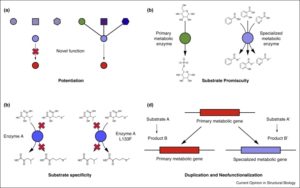 The huge set of chemical pathways beyond the conserved primary metabolic network is described as specialized metabolism (formerly known as secondary metabolism). The diversity of specialized metabolites is due to recent evolutionary innovations in enzyme function, as reviewed by Leong and Last. Key processes include enzyme and substrate promiscuity, changes in substrate specificity, and of course gene duplication and divergence. The authors provide examples of the involvement of these processes in the evolution of specialized metabolism. Case studies include: an enzyme involved in glucosinolate synthesis, BAHD acyltransferases, 4-coumarate:CoA ligase, and aromatic acid methyltransferases. Curr. Opin. Struct. Biol. 10.1016/j.sbi.2017.07.005
The huge set of chemical pathways beyond the conserved primary metabolic network is described as specialized metabolism (formerly known as secondary metabolism). The diversity of specialized metabolites is due to recent evolutionary innovations in enzyme function, as reviewed by Leong and Last. Key processes include enzyme and substrate promiscuity, changes in substrate specificity, and of course gene duplication and divergence. The authors provide examples of the involvement of these processes in the evolution of specialized metabolism. Case studies include: an enzyme involved in glucosinolate synthesis, BAHD acyltransferases, 4-coumarate:CoA ligase, and aromatic acid methyltransferases. Curr. Opin. Struct. Biol. 10.1016/j.sbi.2017.07.005
Review: Plant signaling and metabolic pathways enabling arbuscular mycorrhizal symbiosis ($)
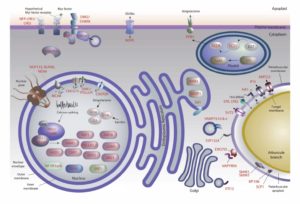 The relationship between plants and arbuscular mycorrhizal fungi has persisted for 400 million years, but we are still learning about the biochemistry of this interaction. MacLean, Bravo and Harrison review how plants attract, recognize, and accommodate their fungal partners, from pre-contact through nutrient exchange. Recent insights including the role of the NOPE1 N-acetylglucosamine transporter in maize and rice, and the transfer of fatty acids from plant to fungus are also discussed. Plant Cell
The relationship between plants and arbuscular mycorrhizal fungi has persisted for 400 million years, but we are still learning about the biochemistry of this interaction. MacLean, Bravo and Harrison review how plants attract, recognize, and accommodate their fungal partners, from pre-contact through nutrient exchange. Recent insights including the role of the NOPE1 N-acetylglucosamine transporter in maize and rice, and the transfer of fatty acids from plant to fungus are also discussed. Plant Cell
Review: Cutin from agro-waste as a raw material for the production of bioplastic ($)
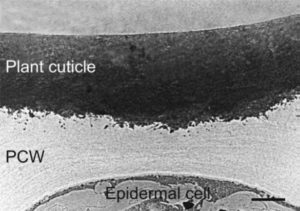 When we think about making things from plant biopolymers, we often think about cellulose, the “most common natural polymer on Earth, with an estimated annual biomass production between 1011 and 1012 tons” or ligin, with a biomass production on the order of 107 tons per year. Heredia-Guerrero et al. review efforts to use another cell wall biopolymer, cutin, which they estimate being is produced in agro waste at 105 – 106 tons per year. Cutin is “the polymeric network support of the plant cuticle” and consists of esterified bi- and trifunctional fatty acids. The authors describe the process of obtaining raw material from cutin (mainly from tomato fruit peels removed during processing), and its physical properties as compared to other materials used for plastic production. Material generated from cutin holds the promise of greater biodegradability and supports a bio-based, curcular economy due to its beginning as a waste product. J. Exp. Bot. 10.1093/jxb/erx272
When we think about making things from plant biopolymers, we often think about cellulose, the “most common natural polymer on Earth, with an estimated annual biomass production between 1011 and 1012 tons” or ligin, with a biomass production on the order of 107 tons per year. Heredia-Guerrero et al. review efforts to use another cell wall biopolymer, cutin, which they estimate being is produced in agro waste at 105 – 106 tons per year. Cutin is “the polymeric network support of the plant cuticle” and consists of esterified bi- and trifunctional fatty acids. The authors describe the process of obtaining raw material from cutin (mainly from tomato fruit peels removed during processing), and its physical properties as compared to other materials used for plastic production. Material generated from cutin holds the promise of greater biodegradability and supports a bio-based, curcular economy due to its beginning as a waste product. J. Exp. Bot. 10.1093/jxb/erx272
Review: Senescence and nitrogen use efficiency in perennial grasses for forage and biofuel production ($)
 Much of our understanding of the molecular processes of senescence and nutrient remobilization comes from annual plants. Yang and Udvardi explore how these processes take place in perennial grasses including important biofuel grasses switchgrass (Panicum virgatum) and miscanthus (Miscanthus×giganteus). While in annual plants leaf senescence is usually accompanied by mobilization of nutrients from leaves to seeds, in perennials some of the nutrients mobilized from the leaves is stored in underground organs (roots, rhizomes and crowns) and so not removed from the site, thus requiring less input of fertilizers during the next season. Note that biofuel plants are grown for their carbon-rich biomass, so enhancing N-remobilization into below-ground storage would be environmentally advantageous; by contrast, perennial grasses grown as animal fodder must retain some N-rich proteins in their harvested matter. The authors explore what is known about remobilization in perennial grasses and strategies to breed or engineer improvements, including through changing the timing of reproduction or leaf senescence. J. Exp. Bot. 10.1093/jxb/erx241
Much of our understanding of the molecular processes of senescence and nutrient remobilization comes from annual plants. Yang and Udvardi explore how these processes take place in perennial grasses including important biofuel grasses switchgrass (Panicum virgatum) and miscanthus (Miscanthus×giganteus). While in annual plants leaf senescence is usually accompanied by mobilization of nutrients from leaves to seeds, in perennials some of the nutrients mobilized from the leaves is stored in underground organs (roots, rhizomes and crowns) and so not removed from the site, thus requiring less input of fertilizers during the next season. Note that biofuel plants are grown for their carbon-rich biomass, so enhancing N-remobilization into below-ground storage would be environmentally advantageous; by contrast, perennial grasses grown as animal fodder must retain some N-rich proteins in their harvested matter. The authors explore what is known about remobilization in perennial grasses and strategies to breed or engineer improvements, including through changing the timing of reproduction or leaf senescence. J. Exp. Bot. 10.1093/jxb/erx241
Review: The Chlamydomonas CO2-concentrating mechanism and its potential for engineering photosynthesis in plants
 Many green algae have the ability to concentrate CO2 to enhance their photosynthetic performance. Mackinder reviews these algal CO2-concentrating mechanisms (CCMs) and what steps would be required to introduce them into higher plants. He also compares progress and pitfalls towards introducing algal CCMs into plants to that of other photosynthesis-engineering strategies including Rubisco engineering and C4 engineering. New Phytol. 10.1111/nph.14749
Many green algae have the ability to concentrate CO2 to enhance their photosynthetic performance. Mackinder reviews these algal CO2-concentrating mechanisms (CCMs) and what steps would be required to introduce them into higher plants. He also compares progress and pitfalls towards introducing algal CCMs into plants to that of other photosynthesis-engineering strategies including Rubisco engineering and C4 engineering. New Phytol. 10.1111/nph.14749
Review: Embracing the unknown: disentangling the complexities of the soil microbiome ($)
 The soils microbiome is of course hugely complex and immensely variable. Metagenomics tools allow us to describe the diversity of the soil microbiome, but what that diversity means is best grasped when the microbiome is considered in terms of its ecological functions, as described in this Tansley Insight by Fierer. These ecological functions include numerous biogeochemical processes affection soil chemistry, such as carbon cycling, alterations in the bioavailability of phosphorus (P) and nitrogen (N), and redox changes in other nutrients including sulfur (S), manganese (Mn) and iron (Fe). The author also observes that the Competitor – Stress Tolerator – Ruderal framework is an effective way to think meaningfully about the organisms that make up the soil microbiome (and he provides examples of species that fall into each category). Nat. Rev. Microbio. 10.1038/nrmicro.2017.87
The soils microbiome is of course hugely complex and immensely variable. Metagenomics tools allow us to describe the diversity of the soil microbiome, but what that diversity means is best grasped when the microbiome is considered in terms of its ecological functions, as described in this Tansley Insight by Fierer. These ecological functions include numerous biogeochemical processes affection soil chemistry, such as carbon cycling, alterations in the bioavailability of phosphorus (P) and nitrogen (N), and redox changes in other nutrients including sulfur (S), manganese (Mn) and iron (Fe). The author also observes that the Competitor – Stress Tolerator – Ruderal framework is an effective way to think meaningfully about the organisms that make up the soil microbiome (and he provides examples of species that fall into each category). Nat. Rev. Microbio. 10.1038/nrmicro.2017.87
Opinion: Beyond editing to writing large genomes ($)
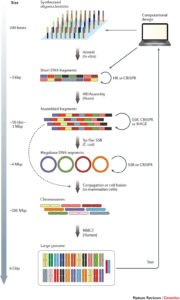 This is an era of rapid acceleration of our ability to both read and write genomes. Chari and Church point to a future in which making a small number of changes in a genome (editing) is supplanted by making hundreds or thousands or more of changes, essentially whole-genome editing. Basically, the authors point out, when genome-wide association studies show us that many genomic loci contribute an effect, why focus on changing just one? They note the numerous potential applications of such genome-wide editing, from human health, to metabolic engineering for small molecule production, to improved crop plants. Besides presenting a fascinating vision of the future, the authors provide a useful directory of DNA-editing nanomachines and they discuss the pros and cons of genome editing versus de novo synthesis. I’d recommend this article to anyone teaching a genetics or molecular biology course – it’s sure to stimulate minds and discussions. Nat. Rev. Genetics 10.1038/nrg.2017.59
This is an era of rapid acceleration of our ability to both read and write genomes. Chari and Church point to a future in which making a small number of changes in a genome (editing) is supplanted by making hundreds or thousands or more of changes, essentially whole-genome editing. Basically, the authors point out, when genome-wide association studies show us that many genomic loci contribute an effect, why focus on changing just one? They note the numerous potential applications of such genome-wide editing, from human health, to metabolic engineering for small molecule production, to improved crop plants. Besides presenting a fascinating vision of the future, the authors provide a useful directory of DNA-editing nanomachines and they discuss the pros and cons of genome editing versus de novo synthesis. I’d recommend this article to anyone teaching a genetics or molecular biology course – it’s sure to stimulate minds and discussions. Nat. Rev. Genetics 10.1038/nrg.2017.59
Opinion: Plant hormones: Key players in gut microbiota and human diseases?
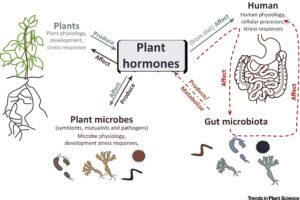 Chanclud and Lacombe have written an intriguing Opinion article asking to what extent plant hormones affect animal gut microbiota and human disease. In support of this question, they observe that many microbes and even some animals can perceive and respond to plant hormones, or produce plant-hormone mimics. Consider for example salicylic acid, a plant hormone that in its native and acetylated form (aspirin) form has diverse effects in humans. Furthermore, studies have shown that ABA is synthesized in humans and affects glucose uptake, and that gibberellic acids (GAs) have anti-inflammatory properties by dampening the release of proinflammatory interleukins, and the auxin IAA has emerged as a promising agent in cancer therapy. These and other observations are discussed in this unusual thought-experiment. Trends Plant Sci. 10.1016/j.tplants.2017.07.003
Chanclud and Lacombe have written an intriguing Opinion article asking to what extent plant hormones affect animal gut microbiota and human disease. In support of this question, they observe that many microbes and even some animals can perceive and respond to plant hormones, or produce plant-hormone mimics. Consider for example salicylic acid, a plant hormone that in its native and acetylated form (aspirin) form has diverse effects in humans. Furthermore, studies have shown that ABA is synthesized in humans and affects glucose uptake, and that gibberellic acids (GAs) have anti-inflammatory properties by dampening the release of proinflammatory interleukins, and the auxin IAA has emerged as a promising agent in cancer therapy. These and other observations are discussed in this unusual thought-experiment. Trends Plant Sci. 10.1016/j.tplants.2017.07.003
Three-dimensional analysis of chloroplast structures associated with virus infection
 It’s not uncommon for viruses to manipulate the host’s membrane system to create protected structures for viral replication. These viral replication complexes (VRCs) “are thought to shield viruses from host defense systems such as RNA silencing, and … provide a microenvironment for enriching viral replication proteins.” Previous studies have identified VRCs in many different membranes, including those of mitochondria, chloroplast, peroxisome and ER. Jin et al. carried out electron tomography based on transmission electron microscopy to explore the 3D structures of chloroplast VRCs. The resulting images and reconstructions are fascinating reveal new insights into viral replication and chloroplasts under stress. Plant Physiol. 10.1104/pp.17.00871
It’s not uncommon for viruses to manipulate the host’s membrane system to create protected structures for viral replication. These viral replication complexes (VRCs) “are thought to shield viruses from host defense systems such as RNA silencing, and … provide a microenvironment for enriching viral replication proteins.” Previous studies have identified VRCs in many different membranes, including those of mitochondria, chloroplast, peroxisome and ER. Jin et al. carried out electron tomography based on transmission electron microscopy to explore the 3D structures of chloroplast VRCs. The resulting images and reconstructions are fascinating reveal new insights into viral replication and chloroplasts under stress. Plant Physiol. 10.1104/pp.17.00871
Phototropin perceives temperature based on the lifetime of its photoactivated state
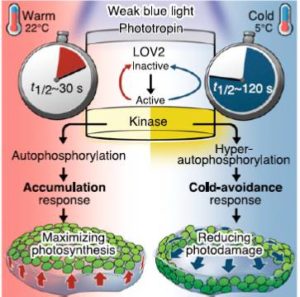 Although plants clearly perceive and respond to changes in temperature, it has not always been clear how they perceive temperature and its changes. Evidence for temperature sensing through membrane fluidity, protein stability and, more recently, the reversion of phytochrome to its inactive form has been shown. Fujii et al. investigated the basis for the temperature-sensitive positioning of chloroplasts; in low light at 22°C, chloroplasts align on the light-facing surface of a cell, whereas at 5°C they line up along the wall parallel to the incident light (to cut down on light interception). The authors showed that the blue-light receptor phototropin is responsible to this temperature-sensitive response, providing another example of temperature-sensing by a photoreceptor. Proc. Natl. Acad. Sci. USA 10.1073/pnas.1704462114
Although plants clearly perceive and respond to changes in temperature, it has not always been clear how they perceive temperature and its changes. Evidence for temperature sensing through membrane fluidity, protein stability and, more recently, the reversion of phytochrome to its inactive form has been shown. Fujii et al. investigated the basis for the temperature-sensitive positioning of chloroplasts; in low light at 22°C, chloroplasts align on the light-facing surface of a cell, whereas at 5°C they line up along the wall parallel to the incident light (to cut down on light interception). The authors showed that the blue-light receptor phototropin is responsible to this temperature-sensitive response, providing another example of temperature-sensing by a photoreceptor. Proc. Natl. Acad. Sci. USA 10.1073/pnas.1704462114
Auxin minimum triggers the developmental switch from cell division to cell differentiation in the Arabidopsis root ($)
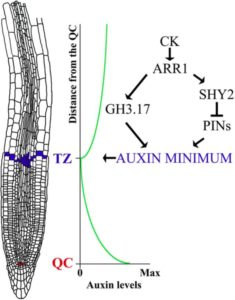 The root apex is an excellent tissue in which to study the mechanisms that control cell division and differentiation, as the cells produced by the root apical meristem form files of increasing age as they are moved away from the tip. In Arabidopsis, many mutant and reporter lines have contributed to a model in which the interplay between the hormones auxin and cytokinin (CK) control cell fate. Di Mambro and De Ruvo et al. explore this interaction further, using molecular genetic and computational modeling approaches. They uncover new roles for cytokinin in the control of the auxin minimum; in addition to CK’s control of the expression of the PIN auxin transporters, it also induces expression of enzymes that induce auxin conjugation and inactivation. They authors also show that the position of the auxin minimum determines the position of the transition zone between dividing and expanding cells and thus root meristem size. Proc. Natl. Acad. Sci. USA 10.1073/pnas.1705833114
The root apex is an excellent tissue in which to study the mechanisms that control cell division and differentiation, as the cells produced by the root apical meristem form files of increasing age as they are moved away from the tip. In Arabidopsis, many mutant and reporter lines have contributed to a model in which the interplay between the hormones auxin and cytokinin (CK) control cell fate. Di Mambro and De Ruvo et al. explore this interaction further, using molecular genetic and computational modeling approaches. They uncover new roles for cytokinin in the control of the auxin minimum; in addition to CK’s control of the expression of the PIN auxin transporters, it also induces expression of enzymes that induce auxin conjugation and inactivation. They authors also show that the position of the auxin minimum determines the position of the transition zone between dividing and expanding cells and thus root meristem size. Proc. Natl. Acad. Sci. USA 10.1073/pnas.1705833114
Architecture and dynamics of the jasmonic acid gene regulatory network
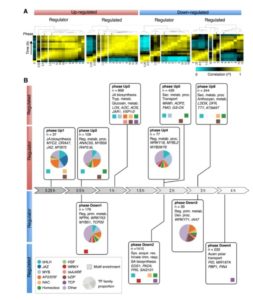 Jasmonic acid (JA) and its derivatives including methyl jasmonate (MeJA) mediate diverse responses to wounding and herbivory and also help to control the growth-defense trade off. JA’s core signaling components have mainly been identified through genetics approaches in Arabidopsis, but knowledge gaps remain between JA synthesis / receptor interactions and downstream responses. Hickman and Van Verk et al. carried out a detailed temporal transcriptional profile of Arabidopsis plants treated with MeJA (which is readily converted to JA) to assemble a gene regulatory network. They also examined several transcription factor mutants to correlate which transcription factors regulate which downstream genes. They conclude, “Our time series study shows that MeJA induces a burst of transcriptional activity that generates a variety of detailed temporal expression patterns that partition into specific gene clusters representing different biological processes.” Plant Cell
Jasmonic acid (JA) and its derivatives including methyl jasmonate (MeJA) mediate diverse responses to wounding and herbivory and also help to control the growth-defense trade off. JA’s core signaling components have mainly been identified through genetics approaches in Arabidopsis, but knowledge gaps remain between JA synthesis / receptor interactions and downstream responses. Hickman and Van Verk et al. carried out a detailed temporal transcriptional profile of Arabidopsis plants treated with MeJA (which is readily converted to JA) to assemble a gene regulatory network. They also examined several transcription factor mutants to correlate which transcription factors regulate which downstream genes. They conclude, “Our time series study shows that MeJA induces a burst of transcriptional activity that generates a variety of detailed temporal expression patterns that partition into specific gene clusters representing different biological processes.” Plant Cell
MicroRNAs from the parasitic plant Cuscuta campestris target host messenger RNAs
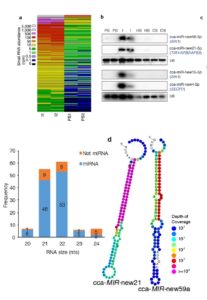 There’s only one thing worse than having a parasite suck the life juices out of you, and that’s having a parasite suck the life juices out of you while simultaneously injecting you with miRNAs to increase your vulnerability. Shahid et al. looked at microRNAs isolated from dodder (Cuscuta campestris), which parasistizes a wide range of eudicots. They found that during parasitism dodder produces 22 nt miRNAs that recognize mRNA sequences of many of its hosts; 22 nt miRNAs are rare and associated with the production of siRNAs from their targets, which can lead to enhanced gene silencing. Mutation of one of the targeted genes, SIEVE ELEMENT OCCLUSION RELATED 1 (SEOR1) led to an increase in biomass of the parasite, which suggests that dodder’s miRNA production contributes to its success as a parasite. bioRxiv 10.1101/180497
There’s only one thing worse than having a parasite suck the life juices out of you, and that’s having a parasite suck the life juices out of you while simultaneously injecting you with miRNAs to increase your vulnerability. Shahid et al. looked at microRNAs isolated from dodder (Cuscuta campestris), which parasistizes a wide range of eudicots. They found that during parasitism dodder produces 22 nt miRNAs that recognize mRNA sequences of many of its hosts; 22 nt miRNAs are rare and associated with the production of siRNAs from their targets, which can lead to enhanced gene silencing. Mutation of one of the targeted genes, SIEVE ELEMENT OCCLUSION RELATED 1 (SEOR1) led to an increase in biomass of the parasite, which suggests that dodder’s miRNA production contributes to its success as a parasite. bioRxiv 10.1101/180497
DELLA genes restrict inflorescence meristem function independently of plant height
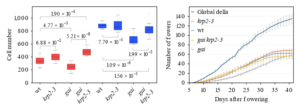 Gibberellins (GA) have a role in cell proliferation in the shoot apical meristem (SAM). GA binds to the receptor GID1, leading to DELLA protein degradation, thus promoting stem growth. In absence of GA, DELLAs inhibit growth. In this paper, Serrano-Mislata et al. explore how DELLAs, mainly GAI and RGA, control stem growth. Their results show that DELLAs have an important role in limiting inflorescence meristem size by affecting cell proliferation partially through the regulation of KARP2 expression, a cell cycle regulator. This function on meristem size determination is uncoupled from subsequent regulation of stem elongation. Furthermore, the effect of DELLAs on increasing meristem size is correlated with development of fewer floral buds. As this role was found to be conserved in barley, it sheds light on the many roles these proteins have on development and provides insights towards improving yield potential in many species of interest for humankind. (Summary by Gabriela Auge). Nature Plants 10.1038/s41477-017-0003-y
Gibberellins (GA) have a role in cell proliferation in the shoot apical meristem (SAM). GA binds to the receptor GID1, leading to DELLA protein degradation, thus promoting stem growth. In absence of GA, DELLAs inhibit growth. In this paper, Serrano-Mislata et al. explore how DELLAs, mainly GAI and RGA, control stem growth. Their results show that DELLAs have an important role in limiting inflorescence meristem size by affecting cell proliferation partially through the regulation of KARP2 expression, a cell cycle regulator. This function on meristem size determination is uncoupled from subsequent regulation of stem elongation. Furthermore, the effect of DELLAs on increasing meristem size is correlated with development of fewer floral buds. As this role was found to be conserved in barley, it sheds light on the many roles these proteins have on development and provides insights towards improving yield potential in many species of interest for humankind. (Summary by Gabriela Auge). Nature Plants 10.1038/s41477-017-0003-y
Detection of nucleic acid–protein interactions in leaves using fluorescence lifetime imaging microscopy ($)
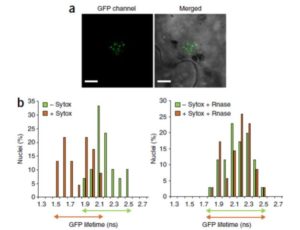 FRET-FLIM (Fluorescence Resonance Energy Transfer – Fluorescent Lifetime Imaging Microscopy) is a method that allows detection of interactions between two fluorescently-tagged molecules. Camborde and Jauneau et al. describe the use of FRET-FLIM to identify in leaves interactions between GFP-tagged DNA-binding proteins and nucleic acids (DNA or RNA), labeled with Sytox Orange. When the two molecules are in proximity, energy is transferred from GFP to Sytox Orange, which decreases the fluorescence lifetime of the GFP. Like other articles in Nature Protocols, this article provides a very detailed method with plenty of hints for troubleshooting. Nature Protocols 10.1038/nprot.2017.076
FRET-FLIM (Fluorescence Resonance Energy Transfer – Fluorescent Lifetime Imaging Microscopy) is a method that allows detection of interactions between two fluorescently-tagged molecules. Camborde and Jauneau et al. describe the use of FRET-FLIM to identify in leaves interactions between GFP-tagged DNA-binding proteins and nucleic acids (DNA or RNA), labeled with Sytox Orange. When the two molecules are in proximity, energy is transferred from GFP to Sytox Orange, which decreases the fluorescence lifetime of the GFP. Like other articles in Nature Protocols, this article provides a very detailed method with plenty of hints for troubleshooting. Nature Protocols 10.1038/nprot.2017.076



